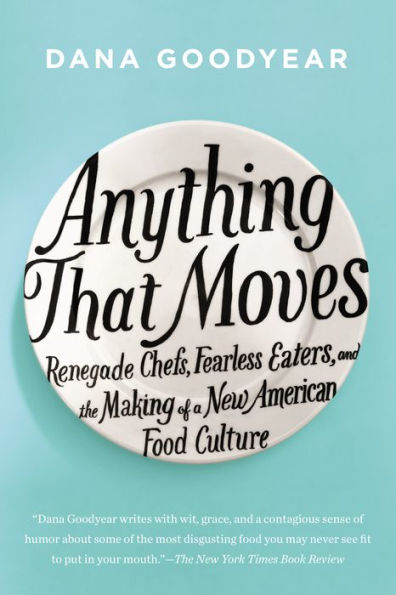Announcing the 2017 Discover Awards Finalists One of the best parts of a bookseller’s gig is championing up-and-coming writers, and one of the ways we do that here at B&N is with our Discover Great New Writers program, which includes our annual Discover Awards. The Discover selection committee is made up of B&N booksellers from […]
The popular New Yorker writer combines the style of Mary Roach with the on-the-ground food savvy of Anthony Bourdain.
Dana Goodyear’s narrative debut is a highly entertaining, revelatory look into the raucous, strange, fascinatingly complex world of contemporary American food culture. At once an uproarious behind-the-scenes adventure and a serious attempt to understand the implications of an emergent new cuisine, it introduces a cast of compelling and unexpected characters—from Los Angeles Times critic Jonathan Gold, to a high-end Las Vegas purveyor of rare and exotic ingredients, to the traffickers and promoters of raw milk and other forbidden products, to the hottest chefs who rely on them—all of whom, along with today’s diners, are changing the face of American eating.
Ultimately, Goodyear looks at what we eat, and tells us who we are. As she places all of this within a vivid historical and cultural framework, she shows how these gathering culinary trends may eventually shape the way all Americans dine. What emerges is a picture of America at a moment of transition, designing the future as it reimagines the past.
"1114980152"
Dana Goodyear’s narrative debut is a highly entertaining, revelatory look into the raucous, strange, fascinatingly complex world of contemporary American food culture. At once an uproarious behind-the-scenes adventure and a serious attempt to understand the implications of an emergent new cuisine, it introduces a cast of compelling and unexpected characters—from Los Angeles Times critic Jonathan Gold, to a high-end Las Vegas purveyor of rare and exotic ingredients, to the traffickers and promoters of raw milk and other forbidden products, to the hottest chefs who rely on them—all of whom, along with today’s diners, are changing the face of American eating.
Ultimately, Goodyear looks at what we eat, and tells us who we are. As she places all of this within a vivid historical and cultural framework, she shows how these gathering culinary trends may eventually shape the way all Americans dine. What emerges is a picture of America at a moment of transition, designing the future as it reimagines the past.
Anything That Moves: Renegade Chefs, Fearless Eaters, and the Making of a New American Food Culture
The popular New Yorker writer combines the style of Mary Roach with the on-the-ground food savvy of Anthony Bourdain.
Dana Goodyear’s narrative debut is a highly entertaining, revelatory look into the raucous, strange, fascinatingly complex world of contemporary American food culture. At once an uproarious behind-the-scenes adventure and a serious attempt to understand the implications of an emergent new cuisine, it introduces a cast of compelling and unexpected characters—from Los Angeles Times critic Jonathan Gold, to a high-end Las Vegas purveyor of rare and exotic ingredients, to the traffickers and promoters of raw milk and other forbidden products, to the hottest chefs who rely on them—all of whom, along with today’s diners, are changing the face of American eating.
Ultimately, Goodyear looks at what we eat, and tells us who we are. As she places all of this within a vivid historical and cultural framework, she shows how these gathering culinary trends may eventually shape the way all Americans dine. What emerges is a picture of America at a moment of transition, designing the future as it reimagines the past.
Dana Goodyear’s narrative debut is a highly entertaining, revelatory look into the raucous, strange, fascinatingly complex world of contemporary American food culture. At once an uproarious behind-the-scenes adventure and a serious attempt to understand the implications of an emergent new cuisine, it introduces a cast of compelling and unexpected characters—from Los Angeles Times critic Jonathan Gold, to a high-end Las Vegas purveyor of rare and exotic ingredients, to the traffickers and promoters of raw milk and other forbidden products, to the hottest chefs who rely on them—all of whom, along with today’s diners, are changing the face of American eating.
Ultimately, Goodyear looks at what we eat, and tells us who we are. As she places all of this within a vivid historical and cultural framework, she shows how these gathering culinary trends may eventually shape the way all Americans dine. What emerges is a picture of America at a moment of transition, designing the future as it reimagines the past.
12.99
In Stock
5
1

Anything That Moves: Renegade Chefs, Fearless Eaters, and the Making of a New American Food Culture
272
Anything That Moves: Renegade Chefs, Fearless Eaters, and the Making of a New American Food Culture
272Related collections and offers
12.99
In Stock

Product Details
| ISBN-13: | 9781101632062 |
|---|---|
| Publisher: | Penguin Publishing Group |
| Publication date: | 11/14/2013 |
| Sold by: | Penguin Group |
| Format: | eBook |
| Pages: | 272 |
| File size: | 799 KB |
| Age Range: | 18 Years |
About the Author

What People are Saying About This
From the B&N Reads Blog
